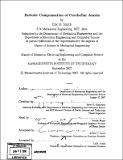| dc.contributor.advisor | Steve G. Massaquoi. | en_US |
| dc.contributor.author | Smith, Eric D., S.M. Massachusetts Institute of Technology | en_US |
| dc.contributor.other | Massachusetts Institute of Technology. Dept. of Electrical Engineering and Computer Science. | en_US |
| dc.date.accessioned | 2008-09-03T15:18:24Z | |
| dc.date.available | 2008-09-03T15:18:24Z | |
| dc.date.copyright | 2007 | en_US |
| dc.date.issued | 2007 | en_US |
| dc.identifier.uri | http://hdl.handle.net/1721.1/42311 | |
| dc.description | Thesis (S.M.)--Massachusetts Institute of Technology, Dept. of Mechanical Engineering; and, (S.M.)--Massachusetts Institute of Technology, Dept. of Electrical Engineering and Computer Science, 2007. | en_US |
| dc.description | Includes bibliographical references (p. 115-117). | en_US |
| dc.description.abstract | The cerebellum is believed to play a role in dynamic compensation in the human motor control system. When it is damaged, subjects make clumsy movements with reduced acceleration, increased overshoot, and swerving in multi-joint movements. These errors, which are referred to clinically as ataxia, are consistent with failing to compensate for the dynamics of the body, especially its inertia during high speed movements. We have developed a robotic system that is capable of dynamically canceling some of the inertial effects in order to reduce the severity of ataxia. This compensator is designed by modeling the closed loop behavior of a subject coupled to a robotic manipulandum. The model is used to solve for the controller needed to produce dynamics in which the inertia of the subject's limb is effectively reduced. The performance of the inertial compensator was tested on both real subjects and a mechanical model designed to reproduce the primary features the subjects' dynamics. The mechanical model provides known and consistent dynamics which facilitates analysis of the compensator performance. The mechanical model confirmed the functionality of the inertial compensator by demonstrating an increase in both the natural frequency and damping ratio of the mechanical model's mass-spring-damper like dynamics. The effect of the inertial compensator on subjects with cerebellar ataxia was measured by their performance on a timed tracing task. The subject with pure ataxia showed a significant improvement in tracing accuracy under inertial compensation, when compared with uncompensated motions. | en_US |
| dc.description.abstract | (cont.) This thesis demonstrates that, in at least some situations, it is possible to mechatronically compensate for the errors associated with cerebellar ataxia by correcting for the dynamics of the limb. This demonstration lends support to the theory that the cerebellum plays a role in dynamics compensation, and it also lays the groundwork for future robotic correction of cerebellar ataxia, a disorder for which there is currently no treatment. | en_US |
| dc.description.statementofresponsibility | by Eric D. Smith. | en_US |
| dc.format.extent | 117 p. | en_US |
| dc.language.iso | eng | en_US |
| dc.publisher | Massachusetts Institute of Technology | en_US |
| dc.rights | M.I.T. theses are protected by
copyright. They may be viewed from this source for any purpose, but
reproduction or distribution in any format is prohibited without written
permission. See provided URL for inquiries about permission. | en_US |
| dc.rights.uri | http://dspace.mit.edu/handle/1721.1/7582 | en_US |
| dc.subject | Mechanical Engineering. | en_US |
| dc.subject | Electrical Engineering and Computer Science. | en_US |
| dc.title | Robotic compensation of cerebellar ataxia | en_US |
| dc.type | Thesis | en_US |
| dc.description.degree | S.M. | en_US |
| dc.contributor.department | Massachusetts Institute of Technology. Department of Electrical Engineering and Computer Science | |
| dc.contributor.department | Massachusetts Institute of Technology. Department of Mechanical Engineering | |
| dc.identifier.oclc | 232550801 | en_US |
